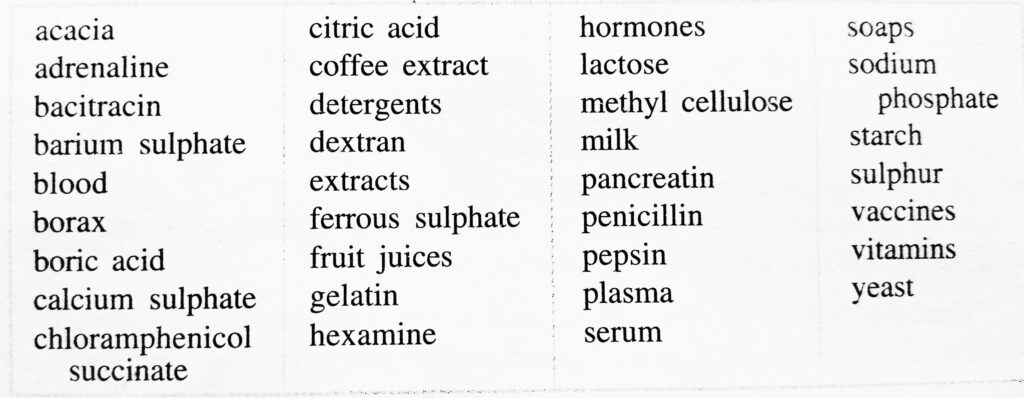Table of Contents
Principle of the spray dryer
In a spray dryer, the fluid to be dried is atomized into fine droplets, which are thrown radially into a moving stream of hot gas. The temperature of the droplets is immediately increased and fine droplets get dried instantaneously in the form of spherical particles. This process completes in a few seconds before the droplets reach the wall of the dryer.
Construction of the spray dryer
The construction of a spray dryer is shown in Figure 1.1. It consists of a large cylindrical drying chamber with a short conical bottom, made up of stainless steel (the diameter of the drying chamber ranges between 2.5 to 9.0 meters, and the height is 25.0 meters or more). An inlet for hot air is placed on the roof of the chamber. Another inlet carrying a spray-disk atomizer is set on the roof (shown in Figure 1.1). The spray disk atomizer is about 300 millimeters in diameter and rotates at a speed of 3,000 to 50,000 revolutions per minute. The bottom of the dryer is connected to a cyclone separator.

Working on spray dryer
Drying of the material in the spray dryer involves 3 stages.
- Atomization of the liquid.
- Drying of the liquid droplets.
- Recovery of the dried product.
Atomization of the liquid to form liquid droplets: The feed is introduced through the atomizer either by gravity or by using a suitable pump to form fine droplets. The properties of the final product depend on the droplet form, hence, the selection of the type of atomizer is important. An atomizer of any type: the pneumatic atomizer, pressure nozzle, and spinning disc atomizer may be used.
The rate of feed is adjusted in such a way that the droplets should be completely dried before reaching the walls of the drying chamber. At the same time, the product should not be overheated.
Drying of the liquid droplets: Fine droplets are dried in the drying chamber by supplying hot air through the inlet.
The surface of the liquid drop is dried immediately to form a tough shell. Further, the liquid inside must escape by diffusing through the shell at a rate. At the same time, heat transfer from outside to inside takes place at a rate greater than the liquid diffusion rate. As a result, the heat inside mounts up which allows the liquid to evaporate at a faster rate. This tendency of a liquid lead causes the droplets to swell. to rise in the internal pressure The shell’s thickness decreases whereas permeability for vapor increases. If the shell is neither elastic nor permeable, it ruptures and the internal pressure escapes.
The temperature of the air is adjusted in such a way that the droplets should be completely dried before reaching the walls of the drying chamber. At the same time, the product should not be overheated. Recovery of the dried product: Centrifugal force of the atomizer drives the droplets to follow a helical path. Particles are dried during their journey and finally fall at the conical bottom.
All these processes are completed in a few seconds. The particle size of the final product ranges from 2 to 500 mm. Particle size depends on solid content in the feed, liquid viscosity, feed rate, and disc speed. Spray dryers of maximum size have got evaporating capacity of up to 2000 kg per hour.
Uses: Spray dryers are used compulsorily, if:
- The product is a better form than that obtained by any other dryer.
- The quantity of the material to be dried is large.
- The product is thermolabile, hygroscopic, or undergoes chemical decomposition.
A few products that are dried using a spray dryer are:

Advantages:
- Spray drying is a continuous process and drying is very rapid. Drying completes within 3 to 30 seconds.
- Labor costs are low as it combines the function of an evaporator, a crystallizer, a dryer, a size reduction unit, and a classifier.
- By using a suitable atomizer, the product of uniform and controllable size can be obtained. A free-flowing product of uniform spheres is formed which is very convenient for the tableting process.
- Fine droplets are formed to provide a large surface area for heat and mass transfer. The product shows excellent solubility.
- Either the solution or suspension or thin paste can be dried in one step to get the final product ready for the package.
- It is suitable for the drying of sterile products.
- Reconstituted product appears more or less similar to the fresh material.
- Globules of an emulsion can be dried with the dispersed phase inside and a layer of the continuous phase outside. On reconstitution, the emulsion will be formed…
Disadvantages:
- The spray dryer is very bulky (height of 25.0 meters and diameter of 9.0 meters) and expensive.
- Such huge equipment is not always easy to operate.
- The thermal efficiency is low, as much heat is lost in the discharged gases.
Variants:
- A spray dryer can be constructed in such a way as to suit sterile products.
- It can be operated under closed conditions to recover solvents.
- It can be operated in an oxygen-free environment.
- It can be constructed in such a way that the flow of liquid and gas may be co-current, counter-current, or a combination of both in the same unit.
- The same equipment can be used for spray congealing.
- It is useful for encapsulation (coating) of solid and liquid particles.
Make sure you also check our other amazing Article on : Drum Dryer
